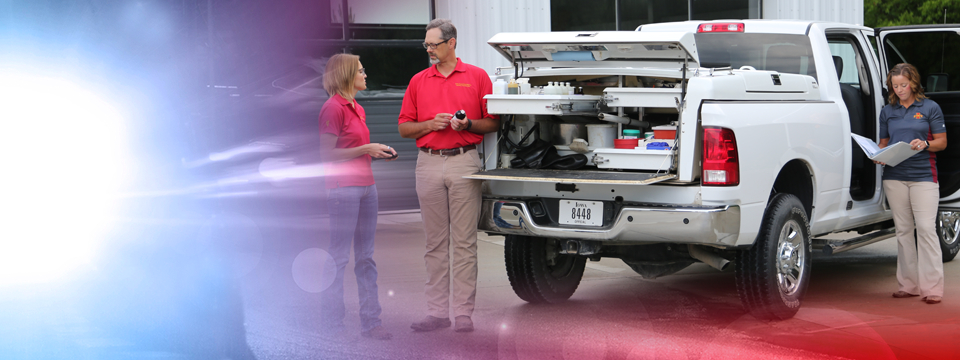
The call comes early in the morning. Local emergency responders have requested assistance with an accident involving a livestock trailer. Two veterinary trucks are dispatched loaded with equipment, driven by clinicians with a variety of expertise and veterinary students riding along ready to help.
The veterinary field services unit at Iowa State University’s College of Veterinary Medicine receives two to three calls for assistance a year and each one never the same. “The college has assisted emergency responders when trailers have been stuck in snowstorms, when trailers have mechanical difficulties with animals aboard, and when there’s been an accident” said Dr. Troy Brick (’02), field services clinician.
Responding to these types of calls is something that the college, and Brick, believes is an important part of its mission to serve the community. The calls also serve as valuable, real-life training for veterinary students who, in turn, may have an opportunity to use the experience in their own communities after graduation.
Teachable Moments
Brick says that the objectives for these calls are the same as any practitioner has when responding to a call. “We must ensure the safety of the responders as well as the health and welfare of the animals.” Evaluate the situation and decide how to manage it.
Those objectives can be taught in the classroom. But, many lessons come only through experience. For instance, the magnitude and sense of urgency of a livestock trailer accident involving multiple animals can’t be recreated in the classroom.
In these situations, the minutes are ticking. “And, the number one limiting factor is time, and time becomes mortality,” says Dr. Locke Karriker, professor and director of the ISU’s Swine Medicine Education Center. “We teach the students that if you stay calm, you can help the pigs faster than if you rush around. Hurried is not the same as fast; and frantic is never fast.”
Hazards and More Hazards
Most students have never been part of a mobile response team, so Karriker tries to prepare them for what they might encounter as they drive to the scene. “Sometimes, the scene can be emotionally challenging and the severity and type of injuries might be surprising. Often, there are stressed animals that are going to react behaviorally and physiologically in different ways than they would normally.”
He also goes over safety protocols, reminding the students to be “situationally aware” as they are moving around the scene. “It’s easy to get caught up in the situation and not see potential dangers, such as passing vehicles or an unstable gate inside the trailer,” he said.
Next, Karriker goes over the order of operations. “We’ll first need to get all of the mobile animals off as fast as we can so we can tend to the ones that may be stuck or injured.” Often, the veterinary response team has a stock trailer in tow. This trailer is equipped with panels and other equipment that will help them to safely off load animals, and subsequently serve as a holding area and transport vehicle for the uninjured.
Collegiality and Cooperation
In any emergency incident, you want calmness to prevail. And, most important, you want everyone to work together. “When we arrive, there may be firefighters and police, as well as other emergency personnel already on the scene,” Brick says. “It’s an important take-away for the students to see how well we work together with the other agencies.”
Karriker says most of our students have not had interactions with the police, other than perhaps getting a traffic ticket. “Here, the students walk with us to the officers to talk strategy.” The students also see colleagues working well with each other. “No one is a specialist in trailer accidents,” Karriker said.
“I came to ISU because we have every resource, and everyone works together extremely well,” Brick adds. “We’re always willing and able to help our clients and the public. I’m happy to help out in whatever way is needed — maybe it’s rounding up loose cattle, or maybe it’s carrying equipment to where it’s needed.”
“Survival of the veterinary profession and the livestock industry is always dependent on people helping each other across disciplines,” Karriker said. “Getting a chance to demonstrate that for a day is an important lesson for our students.”
July 2016
